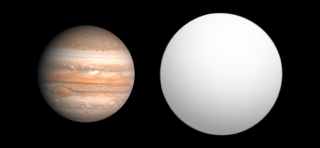Related Research Articles
OGLE-TR-132 is a distant magnitude 15.72 star in the star fields of the constellation Carina. Because of its great distance, about 4,900 light-years, and location in the crowded field it was not notable in any way. Because its apparent brightness changes when one of its planets transits, the star has been given the variable star designation V742 Carinae. The spectral type of the star is type F. A yellow-white, very metal-rich dwarf star, it is slightly hotter and more luminous than the Sun.

OGLE-TR-10b is an extrasolar planet orbiting the star OGLE-TR-10.
Pi Mensae, also known as HD 39091, is a yellow dwarf star in the constellation of Mensa. This star has a high proper motion. The apparent magnitude is 5.67, which can be visible to the naked eye in exceptionally dark, clear skies. It is nearly 60 light-years away. The star is slightly larger than the Sun in terms of mass, size, luminosity, temperature and metallicity, and is about 730 million years younger. It hosts three known planets.
OGLE-TR-113 is a dim, distant magnitude 16 binary star in the star fields of the constellation Carina. Because of its distance of about 1170 light years, and location in a crowded field it was not notable in any way. Its apparent brightness changes when one of its planets transits, so the star has been given the variable star designation V752 Carinae. Spectral type of the star is type K dwarf star, slightly cooler and less luminous than the Sun.
HD 118203 is a star located in the northern circumpolar constellation of Ursa Major. It has the proper name Liesma, which means flame, and it is the name of a character from the Latvian poem Staburags un Liesma. The name was selected in the NameExoWorlds campaign by Latvia, during the 100th anniversary of the IAU.

OGLE-TR-211b is a transiting planet in Carina constellation. Its radius is about 36% more than Jupiter and has mass 3% more than Jupiter, which is considered an “inflated Hot Jupiter”. The planet takes 3.7 days at about the same distance as 51 Pegasi b orbits around 51 Pegasi.
HAT-P-4 is a wide binary star consisting of a pair of G-type main-sequence stars in the constellation of Boötes. It is also designated BD+36°2593.

OGLE-TR-132b is an extrasolar planet orbiting the star OGLE-TR-132.
GSC 03089-00929 is a magnitude 12 star located approximately 760 light-years away in the constellation of Hercules. This star is a G type main sequence star that is similar to but slightly cooler than the Sun. This star is identified in SIMBAD as a variable star per the 1SWASP survey.
GSC 02620-00648 is a double star in the constellation Hercules. The brighter of the pair is a magnitude 12 star located approximately 1,660 light-years away. This star is about 1.18 times as massive as the Sun.
HAT-P-13, also known as GSC 03416-00543, is a G-type main sequence star approximately 800 light-years away in the constellation Ursa Major. In 2009 it was discovered that this star is orbited by two massive planets, the innermost of which transits the star. This was the first known example of an extrasolar transiting planet with an additional planet in the same system.
WASP-18 is a magnitude 9 star located 400 light-years away in the Phoenix constellation of the southern hemisphere. It has a mass of 1.29 solar masses.
WASP-95 is a star 451 light-years away in the constellation Grus. With an apparent magnitude of 10.1, it is not visible to the naked eye. Its spectral type of G2 means it is a yellow sunlike star.
WASP-35 is a G-type main-sequence star about 660 light-years away. The star's age cannot be well constrained, but it is probably older than the Sun. WASP-35 is similar in concentration of heavy elements compared to the Sun.
KELT-10, also known as CD−47°12635, is a sun-like star in the southern constellation Telescopium. It has an apparent magnitude of 10.62, making it readily visible in telescopes, but not to the naked eye. Parallax measurements from the Gaia spacecraft place the star at a distance of 617 light years; it is currently receding with a radial velocity of 31.6 km/s.
WASP-57 is a single G-type main-sequence star about 1310 light-years away. WASP-57 is depleted in heavy elements, having 55% of the solar abundance of iron. WASP-57 is much younger than the Sun at 0.957±0.518 billion years.
CoRoT-16 is a solitary star located in the equatorial constellation Scutum. With an apparent magnitude of 16, it requires a powerful telescope to be seen, and is located 2,400 light years away based on parallax.
References
- 1 2 3 4 5 6 7 8 Vallenari, A.; et al. (Gaia collaboration) (2023). "Gaia Data Release 3. Summary of the content and survey properties". Astronomy and Astrophysics. 674: A1. arXiv: 2208.00211 . Bibcode:2023A&A...674A...1G. doi: 10.1051/0004-6361/202243940 . S2CID 244398875. Gaia DR3 record for this source at VizieR.
- ↑ Stassun, Keivan G.; Oelkers, Ryan J.; Pepper, Joshua; Paegert, Martin; De Lee, Nathan; Torres, Guillermo; Latham, David W.; Charpinet, Stéphane; Dressing, Courtney D.; Huber, Daniel; Kane, Stephen R.; Lépine, Sébastien; Mann, Andrew; Muirhead, Philip S.; Rojas-Ayala, Bárbara; Silvotti, Roberto; Fleming, Scott W.; Levine, Al; Plavchan, Peter; the TESS Target Selection Working Group (2018). "The TESS Input Catalog and Candidate Target List". The Astronomical Journal. 156 (3): 102. arXiv: 1706.00495 . Bibcode:2018AJ....156..102S. doi: 10.3847/1538-3881/aad050 . S2CID 73582386.
- 1 2 3 4 5 6 Udalski, A.; et al. (2008). "OGLE-TR-211 - a new transiting inflated hot Jupiter from the OGLE survey and ESO LP666 spectroscopic follow-up program". Astronomy and Astrophysics. 482 (1): 299–304. arXiv: 0711.3978 . Bibcode:2008A&A...482..299U. doi:10.1051/0004-6361:20079143. S2CID 6756328.
- ↑ Delgado Mena, E.; et al. (April 2015). "Li abundances in F stars: planets, rotation, and Galactic evolution". Astronomy & Astrophysics. 576: 24. arXiv: 1412.4618 . Bibcode:2015A&A...576A..69D. doi:10.1051/0004-6361/201425433. S2CID 56051637. A69.
- 1 2 "SIMBAD query result: OGLE-TR 211 -- Star". Centre de Données astronomiques de Strasbourg . Retrieved 2009-04-30.